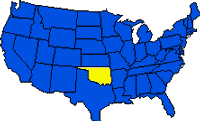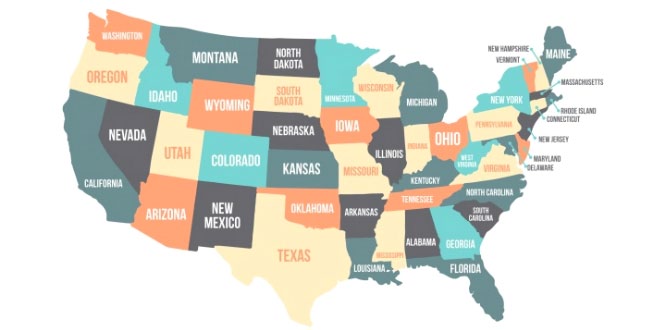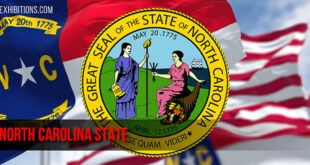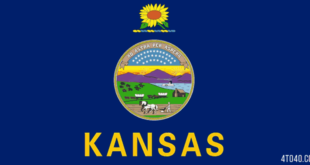 Formed by the union of Oklahoma Territory and Indian Territory, Oklahoma was admitted as the 46th state on Nov. 16, 1907. Oklahoma is a Choctaw word meaning “red man”. Oklahoma has been nicknamed the “Sooner State” for the settlers who tried to enter the area and claim land sooner than it was legal to do so. The state is an important producer of agricultural products, especially wheat, cattle, and cotton, and mineral fuels, notably petroleum products and coal.
Formed by the union of Oklahoma Territory and Indian Territory, Oklahoma was admitted as the 46th state on Nov. 16, 1907. Oklahoma is a Choctaw word meaning “red man”. Oklahoma has been nicknamed the “Sooner State” for the settlers who tried to enter the area and claim land sooner than it was legal to do so. The state is an important producer of agricultural products, especially wheat, cattle, and cotton, and mineral fuels, notably petroleum products and coal.
Oklahoma State: Land & Resources
 Oklahoma is located in the transitional zone between the eastern and western parts of the nation. The Ozark Plateau and the Ouachita Mountains are similar to the Appalachian highlands to the east; the central part of the state constitutes the southern part of the Central Lowlands; and northwestern Oklahoma is a part of the GREAT PLAINS. Elevation increases from 88 m (289 ft) near the southeastern corner of the state to 1,516 m (4,973 ft) on Black Mesa in the northwestern corner of the Panhandle.
Oklahoma is located in the transitional zone between the eastern and western parts of the nation. The Ozark Plateau and the Ouachita Mountains are similar to the Appalachian highlands to the east; the central part of the state constitutes the southern part of the Central Lowlands; and northwestern Oklahoma is a part of the GREAT PLAINS. Elevation increases from 88 m (289 ft) near the southeastern corner of the state to 1,516 m (4,973 ft) on Black Mesa in the northwestern corner of the Panhandle.
The Ouachita Mountains are a series of long, steep-sloped, parallel ridges formed largely by folding and faulting, many capped by a massive layer of sandstone. The region has the greatest relief in Oklahoma. The OZARK MOUNTAINS, or Ozark Plateau, and the Ouachitas are separated by the Arkansas River. The Ozarks are composed of horizontal layers of rocks, mainly limestones and shales. The Wichita Mountains in the southwest are largely granite, rhyolite, and gabbro peaks with boulder-strewn slopes, and much of the Arbuckle region in the south central part of the state is formed of ribbed edges of limestone with complex folds and faults. The Osage Plains in central Oklahoma are underlain by nearly horizontal rocks that dip slightly westward; they are divided into the Eastern Lowlands, Osage Prairies, Cross Timbers, and Western Red Prairies. The Great Plains have elevations that increase westward from 610 to almost 1,525 m (2,000 to 5,000 ft). The northern limits of the Gulf Coastal Plain in the southeast constitute an area of soft sandstone, shale, and limestone.
Rivers and Lakes
All drainage from Oklahoma occurs either by the ARKANSAS RIVER, which crosses the northeastern quarter of the state, or the RED RIVER, which follows the southern boundary. The CANADIAN RIVER, the Cimarron, the Neosho, and the Illinois are major tributaries of the Arkansas. The North Fork of the Red River and the Washita, the Kiamichi, and the Little rivers flow into the Red River. Several large artificial lakes have been formed by the damming of rivers. Eufaula Reservoir, covering 427 sq km (165 sq mi) at normal level, is the largest.
Climate
Oklahoma climate varies from the high, arid continental type in the west to the low, humid subtropical type in the southeast. Rainfall increases from less than 381 mm (15 in) annually in the western Panhandle to more than 1,270 mm (50 in) in the Ouachita Mountains. In the higher, more arid, western part of the state, yearly temperatures range from -23 deg C (-10 deg F) in January to above 38 deg C (100 deg F) in July. In the southeast, temperatures vary from about 0 deg C (32 deg F) in winter to 32 deg C (90 deg F) in July.
Tourism
Railroads, first built in Oklahoma in the 1870s, were an important factor in the state’s development. Extensive road and highway networks, however, have increasingly supplanted railroads for freight transport as well as passenger travel. The McClellan-Kerr Arkansas River Navigation System (1971) links the Tulsa area with the Mississippi River and thus the Gulf of Mexico. Tourism is a growing economic activity in Oklahoma.
Oklahoma State: History
Indians lived in and migrated back and forth across what is now Oklahoma as they hunted for animals and food. The earliest people lived some 15,000 years ago in caves and under rock shelters in the western part of the state.
The Spanish were the first Europeans to explore Oklahoma. Francisco Vazquez de CORONADO crossed the western part of the state in 1541. Later Spanish explorers also crossed western and southern Oklahoma but formed no settlements in the area. The French explored the streams in eastern Oklahoma, and the trader Auguste Pierre Chouteau (see CHOUTEAU family) established the first permanent settlement–now Salina–in 1817.
In 1803 the United States purchased the Louisiana Territory from France, but the limits of the purchased area were not known until the Adams-Onis Treaty was completed in 1819. The Red River and the 100 deg west meridian became boundaries of the American territory and today form the southern and most of the western boundary of Oklahoma. The Panhandle, extending westward to 103 deg west longitude, belonged to Spain until 1821, to Mexico from 1821 to 1836, and to the nation of Texas until 1850, when it became U.S. territory. The Panhandle remained unorganized territory until attached to Oklahoma Territory in 1890.
After the LOUISIANA PURCHASE the area was explored by traders. The traders shipped the goods they bought from Indians downriver past St. Louis to New Orleans on flatboats. In 1808 the powerful OSAGE tribe ceded to the United States all of eastern Oklahoma north of the Arkansas River, and in 1818 the QUAPAW Indians ceded all claims to lands south of the Arkansas in present-day Oklahoma and Arkansas. This cleared the way for enactment of President Jackson’s policy of Indian “consolidation.”
The government of the United States negotiated treaties with the Indians living in the Southeastern part of the nation whereby they would relinquish their Eastern lands in exchange for territory encompassing nearly all of present-day Oklahoma. The FIVE CIVILIZED TRIBES–CHEROKEE, CHICKASAW, CHOCTAW, CREEK, and SEMINOLE–were primarily successful farmers or professionals who adopted many cultural traits of the white settlers. Their removal (1830-40) over the various “trails of tears” resulted in many deaths and severe hardship.
The Choctaws and Cherokees were the first moved. The Choctaws were settled south of the Arkansas and Canadian rivers, the Cherokees on land north and east of the Arkansas River. The Creeks were settled north of the Canadian and west of the Arkansas. At first the Chickasaws were located in the Choctaw Nation and the Seminoles in the Creek Nation, but later each tribe was allotted its own area.
To clear the way for the settlement of the Eastern Indians on Oklahoma lands, the United States government entered into a series of complicated negotiations with the indigenous groups, culminating in a treaty signed Aug. 24, 1835. Under this treaty the COMANCHE, WICHITA, and associated tribes agreed not to make war on persons traveling through their territory and not to interfere with those Eastern Indians who wished to hunt in the territory. The KIOWA signed a similar document two years later.
In the new INDIAN TERRITORY the Five Civilized Tribes organized representative governments, established towns, and developed farms and businesses until the Civil War disrupted their way of life. As many of the Indians were slaveholders, the people of the Five Civilized Tribes were divided in loyalty between the Union and the Confederacy. During the Civil War many homes and towns were destroyed, some battles and several skirmishes were fought, and many Indians were forced to leave their respective nations. Following the Civil War the U.S. government declared these Indians to have been allies of the Confederacy and forced the Five Civilized Tribes to give up their western lands for considerations of 15 to 30 cents an acre. Much of the western area was then divided into reservations on which various Plains Indians–ARAPAHO, CHEYENNE, PAWNEE, Kiowas, Comanches, Wichitas, and smaller tribes–were settled.
The Unassigned Lands near the center of Oklahoma, Old Greer County in the southwest, and the Panhandle were not allotted to any tribes. Texas veterans of the Civil War settled in Old Greer County, and cattle raisers staked out ranches in the Panhandle. Many people, especially the “Boomers” under the leadership of Capt. David L. Payne, demanded that the Unassigned Lands be opened to settlement. On Apr. 22, 1889, the “horse race,” or “run,” method was used to claim the plots in the Unassigned Lands. At later dates the Cheyenne-Arapaho reservation, the Cherokee Outlet, and several other reservations were also established by this method. Enid, Guthrie, and Oklahoma City grew into cities of 5,000 people or more within six hours. The Kiowa-Comanche lands were opened by lottery. The Unassigned Lands was officially designated Oklahoma Territory on May 2, 1890.
With the establishment of the Oklahoma Territory and the rapid increase in population came pressure for statehood. At the same time, settlers demanded that the Indians be confined to certain areas and that the remainder be opened to homesteading. Eventually the U.S. Congress appointed a commission, headed by Sen. Henry L. Dawes, which entered ten years of negotiations with the Five Civilized Tribes. The Dawes Commission was successful in persuading the tribes to divide their lands among the individual members and to abolish their tribal governments.
Allotment of the Indian lands began on Apr. 1, 1899, and was not completed until 1910. By that time the two halves of Oklahoma had been joined in statehood on Nov. 16, 1907. Before this date Indian protest culminated in a meeting in Muskogee on July 14, 1905, when representatives of all sections of the Indian Territory adopted a constitution for a state to be called Sequoyah. Congress, however, refused to recognize the state.
Since statehood in 1907 many changes have taken place. Oklahoma has changed from a rural to an urban state, from an agricultural economy to one based on industry. Its population has increased with each census except 1930 and 1940, during the difficult times of the DUST BOWL and the Depression of the 1930s. Oklahoma has also become an important center for military activities. Petroleum production remains important, but since 1982 the industry has experienced a downturn that has contributed to Oklahoma’s sluggish economy of the 1980s and early 1990s.
Oklahoma State: Land
- Area: 181,048 sq km (69,903 sq mi); rank: 20th.
- Capital and largest city: Oklahoma City (1990 pop., 444,719).
- Counties: 77.
- Elevations: highest–1,516 m (4,973 ft), at Black Mesa; lowest–88 m (289 ft), at the Little River.
Oklahoma State Symbols
Flag:

Statehood:
Nov. 16, 1907; the 46th state.
Nickname:
Sooner State
Bird:

Tree:
Redbud
Flower:

Motto:
Labor Omnia Vincit (“Labor Conquers All Things”)
Song:
“Oklahoma”
 Kids Portal For Parents India Kids Network
Kids Portal For Parents India Kids Network







